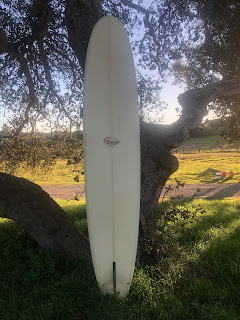8'3" 1968 Rick Surfboards Pintail
From Day Dream Surf Shop web site...
"This 1968 Rick Surfboards is truly a prime example of Evolution Era design and shaping. The wide point of the board is pushed very far forward that transitions into a steep, pulled in pin tail. The rails are relatively foiled the whole length of the board, starting as turned up in the nose, 50/50 mid way through the board, and turned down the last third of the board. The bottom contour is very rolled the whole way through, and the rocker profile is relatively flat with some noticeable S-Deck. The original WaveSet fin is even included with the board. Tap into some period correct Evolution style surfing with this Rick Single fin."
Comments from ''Speed Shaper,'' Rick surfer-shaper back in the day ...
"This is a nice example of the second stage of the mini-gun shape.
I had a first stage version (an incredibly "short" 9'3"-or so it seemed at the time) which had hard rails farther forward from the tail. Catching edges was a constant problem, so Phil Becker started pushing the 50/50 rail more towards the tail before it dropped to a very hard edge, and extending the rounded "belly" in the nose back, too.
An experiment was done to add a bit of Vee in the tail with a slight reverse rocker a few inches from the end. We called them "fluttertails". Phil related to me dropping into a slightly overhead Pipeline wave, leaning over on the rail at the bottom of the wave and the board going straight off! It kept going straight off no matter how hard he leaned until he heard the wave break behind him! At speed, rather than loosening the board up, it "tracked" by resisting turning. This was one of the criticisms of the deep Vee Bottom shapes, too.
The board pictured here is a result of learning those hard lessons. The idea was to get the speed of the pintail plans hape, but make it so that the edges wouldn't grab. But provide just enough edge that it would bite and hold on a hard "rail turn". Keep in mind that the wide point being so far forward, It surfed off of the front foot and committing the rail hard into the turn was the way to maintain that speed. Phil realized that really good surfers could surf anything, but Joe Average needed something a bit forgiving which would allow them to learn edge control and experience the speed that a pintail would provide. They became popular with the people who wanted to "power surf" rather than "hot dog".
The decal pictured is one of the early designs to make the boards look more "hip" and "with" the age of Aquarius, as the double-oval original Rick decal was looking dated, oh so early 60's."





















